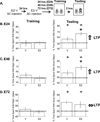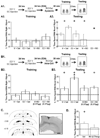Estradiol-induced increase in novel object recognition requires hippocampal NR2B-containing NMDA receptors - PubMed (original) (raw)
Estradiol-induced increase in novel object recognition requires hippocampal NR2B-containing NMDA receptors
Lindsey C Vedder et al. Hippocampus. 2013 Jan.
Abstract
17β-estradiol (E2), at high circulating levels, enhances learning and memory in many women, making it a clinical treatment for hormone-related cognitive decline in aging. However, the mechanisms stimulated by E2, which are responsible for its cognitive enhancing effects, remain incompletely defined. Using an ovariectomized rat model, we previously reported that increasing plasma E2 enhances the magnitude of long-term potentiation (LTP) at hippocampal CA3-CA1 synapses, which is caused by a selective increase in current mediated by NR2B-containing NMDARs, leading to an increase in the NMDAR/AMPAR ratio. Whether the increase in NR2B current is causally related to the ability of E2 to enhance hippocampal dependent learning and memory has yet to be tested. Here, we find that E2 enhances performance in the novel object recognition (NOR) task with the same time course we previously showed E2 enhances the LTP magnitude, temporally linking the increase in LTP to enhanced learning and memory. Furthermore, using the selective NR2B subunit antagonist Ro25-6981, we find that the E2-enhanced NOR, like the enhanced LTP, requires hippocampal NR2B-containing NMDARs, specifically in area CA1. Finally, using whole-cell recordings and the phosphatase inhibitor orthovanadate, we investigated whether the E2-induced increase in NMDAR current is caused by an increase in the density of synaptic NMDARs and/or an increase in NMDAR subunit phosphorylation. We find that both mechanisms are responsible for the enhanced NMDAR current in E2-treated rats. Our results show that the E2-enhanced NOR requires a functional increase in NR2B-containing NMDARs, a requirement shared with the E2-enhanced LTP magnitude at CA3-CA1 synapses, supporting the hypothesis that the increase in LTP likely contributes to the enhanced learning and memory following an increase in plasma E2 levels.
Copyright © 2012 Wiley Periodicals, Inc.
Figures
Figure 1. E2-enhanced NOR occurs at 24 and 48, but not at 72 hours post E2 treatment
A. Experimental timeline. B–D, Left. The average percent time spent investigating the right object during training demonstrates no object preference in E2 and V-treated rats at E24, E48 and E72. B–C, Right. Percent time spent with the novel object at E24 and E48 was significantly greater in E2-treated compared to V-treated rats. D, Right. Percent time spent with novel object at E72 was not different between E2 and V-treated rats. Far right arrows represent LTP at CA3-CA1 synapses for respective time points as reported in Smith and McMahon, 2005. + indicates significance from chance at p<0.05. * indicates significance of hormone treatment at p<0.05.
Figure 2. E2-enhanced NOR is prevented by blocking NR2B-containing NMDARs
A1. Experimental timeline. A2. No object preference during training. A3. Systemic RO (5mg/kg) blocks learning and memory in E2-treated animals only. B1. Experimental timeline for intraCA1 infusion of RO. B2. No object preference during training. B3. IntraCA1 RO (0.375µg/1µL) infusion blocks E2-enhanced learning and memory. Importantly, V-treated animals still spend significantly more time on the novel object compared to chance. C. Cannula tip locations for each animal included in behavioral experiments. Inset: Cresyl violet stained hippocampal brain slice showing representative cannula tip placement. Scale bar represents 100µM. D. Infusion of 3.75µg/1µL RO blocks NOR in V-treated animals. + indicates percent time spent on novel object is significant from chance. *p<0.05 comparing E2 Sal and E2 RO.
Figure 3. E2 enhances both phosphorylation of NR2B-containing NMDARs and total NR2B-containing NMDARs in the synapse
A. Representative traces for each group with over-layed responses for each stimulus intensity. B. Normalized whole-cell recordings of evoked NMDAR EPSCs at increasing stimulus intensities from V-treated animals with (closed squares) or without (closed circles) orthovanadate in the pipet solution and E2-treated animals with (open squares) or without (open circles) orthovanadate. The maximum evoked NMDAR current measured in cells from E2-treated animals is significantly increased above that measured in cells from V-treated rats. Orthovanadate has no effect in cells from E2-treated animals, but significantly enhances the maximum current elicited in cells from V-treated animals. ***p<0.0005, ** p<0.005, *p<0.05. C. Cartoon model illustrating differences in NMDAR receptor density and subunit phosphorylation in CA1 pyramidal cells from E2-treated versus control rats, and the lack of effect of orthovanadate in E2 versus control cells due to E2-induced saturation of subunit phosphorylation.
Similar articles
- 17β estradiol recruits GluN2B-containing NMDARs and ERK during induction of long-term potentiation at temporoammonic-CA1 synapses.
Smith CC, Smith LA, Bredemann TM, McMahon LL. Smith CC, et al. Hippocampus. 2016 Jan;26(1):110-7. doi: 10.1002/hipo.22495. Epub 2015 Oct 1. Hippocampus. 2016. PMID: 26190171 Free PMC article. - Estradiol and the relationship between dendritic spines, NR2B containing NMDA receptors, and the magnitude of long-term potentiation at hippocampal CA3-CA1 synapses.
Smith CC, Vedder LC, McMahon LL. Smith CC, et al. Psychoneuroendocrinology. 2009 Dec;34 Suppl 1:S130-42. doi: 10.1016/j.psyneuen.2009.06.003. Psychoneuroendocrinology. 2009. PMID: 19596521 Free PMC article. Review. - Estradiol-induced increase in the magnitude of long-term potentiation is prevented by blocking NR2B-containing receptors.
Smith CC, McMahon LL. Smith CC, et al. J Neurosci. 2006 Aug 16;26(33):8517-22. doi: 10.1523/JNEUROSCI.5279-05.2006. J Neurosci. 2006. PMID: 16914677 Free PMC article. - Estradiol potentiation of NR2B-dependent EPSCs is not due to changes in NR2B protein expression or phosphorylation.
Snyder MA, Cooke BM, Woolley CS. Snyder MA, et al. Hippocampus. 2011 Apr;21(4):398-408. doi: 10.1002/hipo.20756. Hippocampus. 2011. PMID: 20082293 - Hippocampal long-term synaptic plasticity and signal amplification of NMDA receptors.
MacDonald JF, Jackson MF, Beazely MA. MacDonald JF, et al. Crit Rev Neurobiol. 2006;18(1-2):71-84. doi: 10.1615/critrevneurobiol.v18.i1-2.80. Crit Rev Neurobiol. 2006. PMID: 17725510 Review.
Cited by
- Connecting the Dots: Potential Interactions Between Sex Hormones and the Circadian System During Memory Consolidation.
Boyd HM, Frick KM, Kwapis JL. Boyd HM, et al. J Biol Rhythms. 2023 Dec;38(6):537-555. doi: 10.1177/07487304231184761. Epub 2023 Jul 19. J Biol Rhythms. 2023. PMID: 37464775 Free PMC article. - Examination of Diurnal Variation and Sex Differences in Hippocampal Neurophysiology and Spatial Memory.
Goode LK, Fusilier AR, Remiszewski N, Reeves JM, Abiraman K, Defenderfer M, Paul JR, McMahon LL, Gamble KL. Goode LK, et al. eNeuro. 2022 Nov 15;9(6):ENEURO.0124-22.2022. doi: 10.1523/ENEURO.0124-22.2022. Print 2022 Nov-Dec. eNeuro. 2022. PMID: 36265903 Free PMC article. - Dentate Granule Cells Are Hyperexcitable in the TgF344-AD Rat Model of Alzheimer's Disease.
Smith LA, Goodman AM, McMahon LL. Smith LA, et al. Front Synaptic Neurosci. 2022 May 24;14:826601. doi: 10.3389/fnsyn.2022.826601. eCollection 2022. Front Synaptic Neurosci. 2022. PMID: 35685246 Free PMC article. - A Putative Role for Ubiquitin-Proteasome Signaling in Estrogenic Memory Regulation.
Beamish SB, Frick KM. Beamish SB, et al. Front Behav Neurosci. 2022 Jan 25;15:807215. doi: 10.3389/fnbeh.2021.807215. eCollection 2021. Front Behav Neurosci. 2022. PMID: 35145382 Free PMC article. - Brain-Generated 17β-Estradiol Modulates Long-Term Synaptic Plasticity in the Primary Auditory Cortex of Adult Male Rats.
Soutar CN, Grenier P, Patel A, Kabitsis PP, Olmstead MC, Bailey CDC, Dringenberg HC. Soutar CN, et al. Cereb Cortex. 2022 May 14;32(10):2140-2155. doi: 10.1093/cercor/bhab345. Cereb Cortex. 2022. PMID: 34628498 Free PMC article.
References
- Adams MM, Fink SE, Janssen WG, Shah RA, Morrison JH. Estrogen modulates synaptic N-methyl-D-aspartate receptor subunit distribution in the aged hippocampus. J Comp Neurol. 2004;474(3):419–426. - PubMed
- Buckley MJ. The role of the perirhinal cortex and hippocampus in learning, memory, and perception. The Quarterly journal of experimental psychology. B, Comparative and physiological psychology. 2005;58(3–4):246–268. - PubMed
- Daniel JM, Hulst JL, Lee CD. Role of hippocampal M2 muscarinic receptors in the estrogen-induced enhancement of working memory. Neuroscience. 2005;132(1):57–64. - PubMed
Publication types
MeSH terms
Substances
LinkOut - more resources
Full Text Sources
Miscellaneous


